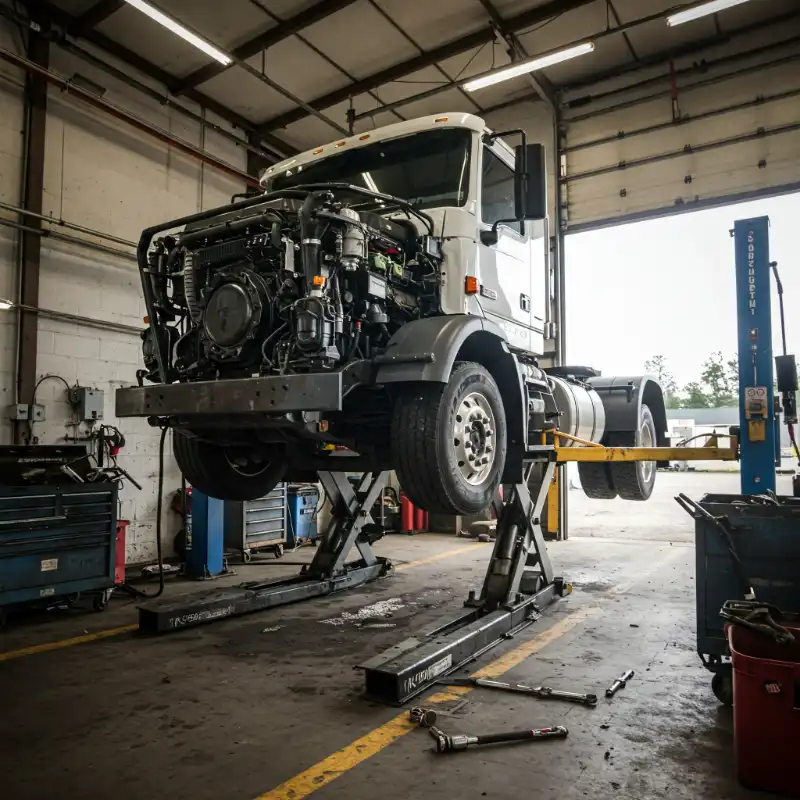Maintaining heavy-duty truck suspensions is essential for a smooth ride, even weight distribution, and overall road safety. Here’s a guide on how to spot and repair some common suspension problems that could slow you down.
Understanding Heavy-Duty Truck Suspension
Heavy-duty truck suspensions come in two primary forms: leaf springs and air suspension. Each type has unique components, pros, and cons. Leaf springs are simple, affordable, and highly durable, often found on trucks meant for hauling heavy loads. Air suspension, on the other hand, provides a smoother, adjustable ride, making it popular on trucks that need a blend of comfort and support.
Common Signs of Suspension Problems
Spotting suspension issues early is critical. Here are some signs to watch out for:
Uneven Tire Wear: If you notice your tires wearing unevenly, it could be a sign of a suspension misalignment. This misalignment often occurs from worn control arms, ball joints, or bushings.
Bouncy Ride: A suspension that no longer absorbs road impacts effectively causes a bouncy ride, often due to worn-out shock absorbers. Shocks are hydraulic components designed to control the suspension’s rebound by slowing the wheels' upward and downward movement after a bump.
Truck Leans or Sags: When a truck leans to one side, a broken leaf spring or deflated airbag could be to blame. Over time, a damaged leaf spring may crack or weaken, leading to sagging. If equipped with air suspension, a leak in the airbag or the airline could result in an uneven stance.
Excessive Vibration: Feeling a lot of vibrations in the steering wheel or the truck’s cab is another indicator of worn suspension parts. This can come from several sources, such as damaged bushings or loose bolts in the suspension setup.
Difficulty Steering: Poor handling or difficulty with steering may be caused by damaged control arms, which connect the suspension to the vehicle’s frame. Control arms guide the wheels' movement up and down while steering, so any wear or breakage affects your steering’s responsiveness.
How to Repair Common Suspension Issues
Replacing Worn Shock Absorbers
Materials Needed: New shocks, wrench set, jack, safety stands
- Raise the truck and secure it with safety stands.
- Remove the mounting bolts from the shock absorbers.
- Slide the old shocks out and replace them with new ones.
- Tighten the bolts securely and lower the truck.
Shocks are essential for handling and ride quality, so replacing them can drastically improve the truck’s comfort and control.
Fixing a Leaking Airbag
Materials Needed: Replacement airbag or airline, soap solution, air compressor
- Spray the airbags with a soap solution to confirm where the leak is.
- Replace any damaged parts, whether it’s the airbag or airline.
- Inflate the airbag and test for further leaks.
- Lower the truck and ensure even inflation.
Replacing an airbag will stabilize the truck’s height, improve load handling, and ensure a smoother ride.
Repairing or Replacing Leaf Springs
Materials Needed: Replacement leaf spring, jack, safety stands, wrench set
- Lift the truck’s rear end and secure it with stands.
- Remove the bolts connecting the leaf spring to the spring hanger.
- Carefully remove the old spring and slide in the replacement.
- Reattach and tighten all bolts, ensuring the new spring is seated correctly.
With new leaf springs, you’ll restore the suspension’s load-bearing capabilities, ensuring an even ride and better weight distribution.
Replacing Worn Bushings
Materials Needed: New bushings, socket wrench set, lubricant
- Identify the bushings that need replacing, often found on control arms or leaf springs.
- Use the socket wrench to remove the old bushings.
- Press or slide the new bushings into place, applying lubricant for easier installation.
- Tighten everything securely.
New bushings reduce vibration and improve stability, resulting in a quieter and more controlled ride.
Preventive Tips for Maintaining Your Truck’s Suspension
Keeping your suspension in top condition helps avoid repairs and downtime. Here are a few preventive maintenance tips:
- Inspect Regularly: Make a habit of checking for wear on all suspension parts, from shocks and bushings to airbags and springs.
- Balance the Load: Uneven loads can overstress one side of your suspension. Be sure to balance your cargo evenly to extend the life of your suspension system.
- Grease Suspension Components: Components like leaf spring hangers and shackles benefit from routine lubrication to prevent rust and reduce friction.
- Check Tire Pressure: Low tire pressure can put added stress on your suspension. Keep tire pressure optimal to help balance the load distribution and reduce strain on your suspension components.
Stay Safe with Regular Inspections
In heavy-duty trucks, suspension problems are not just inconvenient—they’re safety risks. Knowing the signs of suspension issues and how to fix them keeps your truck rolling smoothly, no matter how tough the haul. From bouncy rides due to worn shocks to sagging caused by broken leaf springs, each problem has a solution that keeps you safer on the road and helps avoid long-term damage.
If you’re experiencing any of these issues and aren’t sure where to start, a suspension inspection from OTR Fleet Service can help pinpoint problems and get you back on track.










.webp)





























